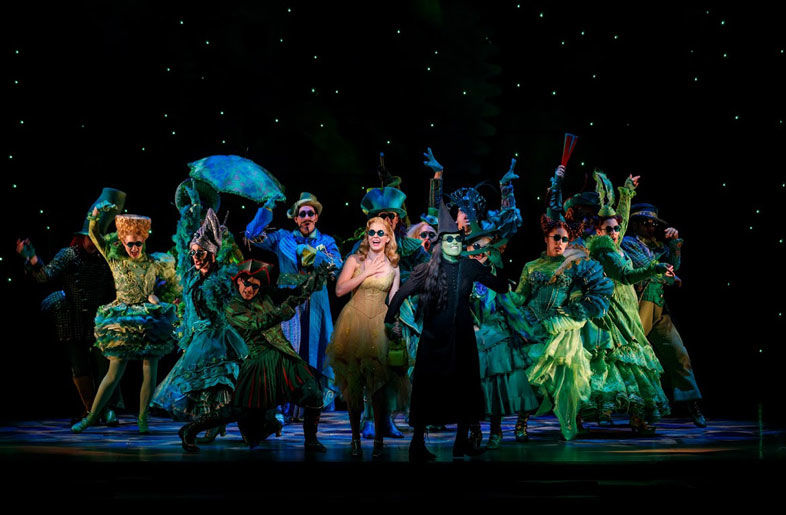How many pre–World War II movies can you name that still delight and inspire 21st-century children? Dorothy’s ruby slippers are in the Smithsonian for a reason: The Wizard of Oz is a timeless piece of fantasy filmmaking that would stand unequaled until Star Wars nearly 40 years later, and remains enchanting 40 years after that. And of all the occasional attempts by other authors to expand on L. Frank Baum’s classic (San Diego connection: Did you know he wrote three of the Oz books while living in Coronado?) none have endured more than Gregory Maguire’s 1995 novel Wicked, which reimagines it from the Witch of the West’s point of view, and its 2003 musical adaptation, which has been running continuously on Broadway for over 6,000 performances and is now playing at the San Diego Civic Theatre for an uncharacteristically long three weeks.The question of why this story and its revisionist counterpart strike such a lasting chord deserves an essay of its own—if there’s one thing postmodern audiences love as much as antiheroes, it’s “mature” remakes of children’s entertainment. But I think it’s at least worth noting here what a quintessentially American antagonist the wizard is, across all adaptations. The carnival barker, the con man, whose contemporary P. T. Barnum allusions are only intensified in Wicked when it’s revealed that he aims to put all the animals in Oz in cages. (The play’s Bush-era genesis shows through in spots, too—the wizard’s plan to surveil his own citizens by way of winged monkeys recalls the Patriot Act, and a “regime change” joke lands with a thud two administrations later.) On these counts, Jason Graae plays the wizard with just the right amount of slime and Shinola, effecting a harmless tophat-twirling old gentleman who at the same time will disappear you without a second thought if you cross him.
But you’re not here for Oz. You’re here for the witches, green-skinned Elphaba (Jackie Burns) and bubbly Glinda (Kara Lindsay), who in this telling met as roommates in college. There’s no way to overstate it: Their voices and stage presence are phenomenal. Lindsay’s soprano sparkles like crystal and she’s an athletic physical comedian to boot; her character embodies that musical theater rule that emotions too powerful to be spoken must be sung, and those too powerful to sing must be danced, as every little overflowing burst of enthusiasm manifests in an involuntary balletic leap or kick. She earns consistent laughs with or without words, especially when she first warms up to Elphaba in “Popular.”And that Elphaba—holy cow. Jackie Burns has played the character longer than anyone, and it’s awe-inspiring seeing her transform from a shy, bookish outcast mocked for her skin color into someone with full knowledge of her identity and in full command of her power. She throws every gesture and facial expression all the way to the top balcony row; when she first lets loose that witchy cackle everyone has no choice but to stand and wait for the applause to die down; and when she takes to the sky in a tempest of smoke and neon for the show’s crowning number, “Defying Gravity,” you feel less like you’re enjoying just another showtune and more like you’ve witnessed the birth of some mythical demigod.

‘Wicked’ Brings Dazzling Sights and Vocal Performances to the Civic Theater
Jackie Burns as Elphaba in “Defying Gravity”
The vocal performances alone would be enough to earn a solid recommendation, but the show is a wonder of costume, sound, and set design as well. Susan Hilferty’s costumes deserve their own exhibit at FIDM, especially the Emerald City ensemble, which are Seussian in their hyperbolic whimsy. Tony Meola’s thundering vocal effects for the floating Oz head rattle the rafters, and Eugene Lee’s kinetic clockwork details in the flyaway set sections are so interesting to look at I’ll forgive the misspelling of “sidereal time” (copy editor; sorry).This was my first time seeing this show, and in that respect the first half ran much more smoothly to me, covering new narrative territory and taking its time to establish Glinda and Elphaba’s friendship and their relationship to the wizard. But once the second half kicks off with Dorothy’s arrival, it loses a lot of momentum to “prequel-itis,” that pesky compulsion to check off all the elements we’re already familiar with, whether they merited an origin story or not. As a childhood fan of the original book, it was disheartening seeing such tragic, cynical alternative takes on the Scarecrow and Tin Woodsman, and distracting wondering how any of this Dorothy-parallel plot fits into the same timeline as the film. But people like me who get hung up on that kind of thing are probably in the minority and missing the point. If you go in accepting that Wicked’s story is its own, and you just sit back and let the music sweep you away, you’ll feel as enchanted as a child (especially if you bring one along).
Wicked, at San Diego Civic TheatreDirected by Joe MantelloThrough November 25Tickets through Broadway/San Diego

‘Wicked’ Brings Dazzling Sights and Vocal Performances to the Civic Theater
The National Touring Company of Wicked | Photo by Joan Marcus


















